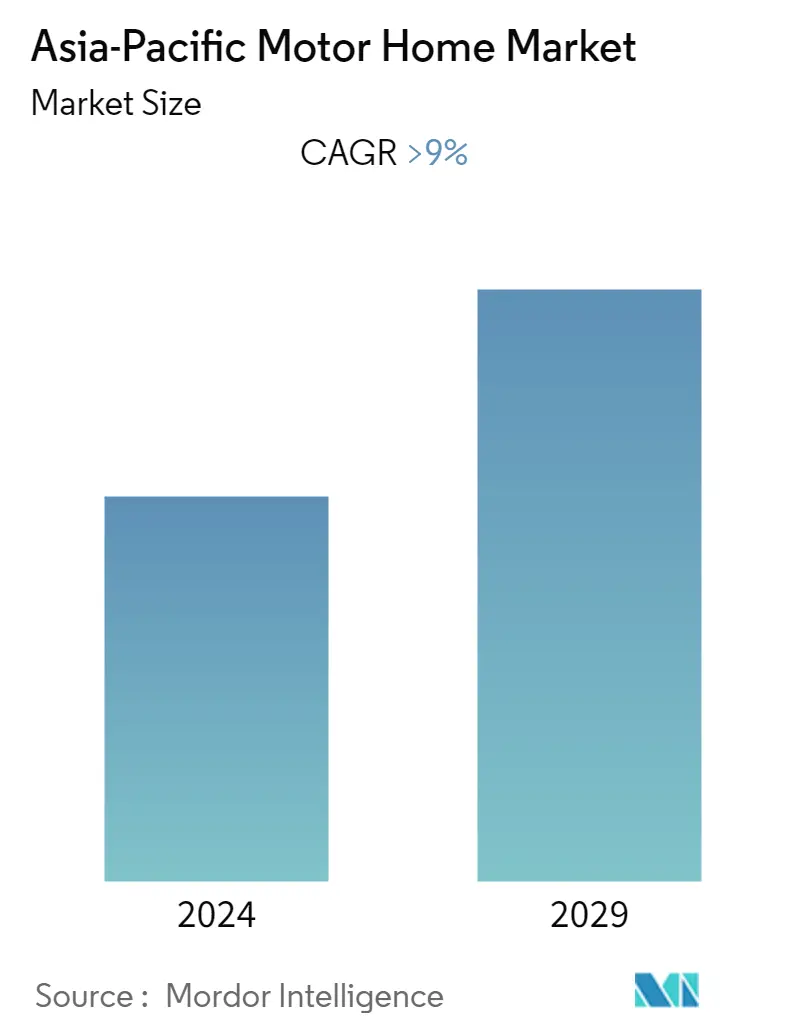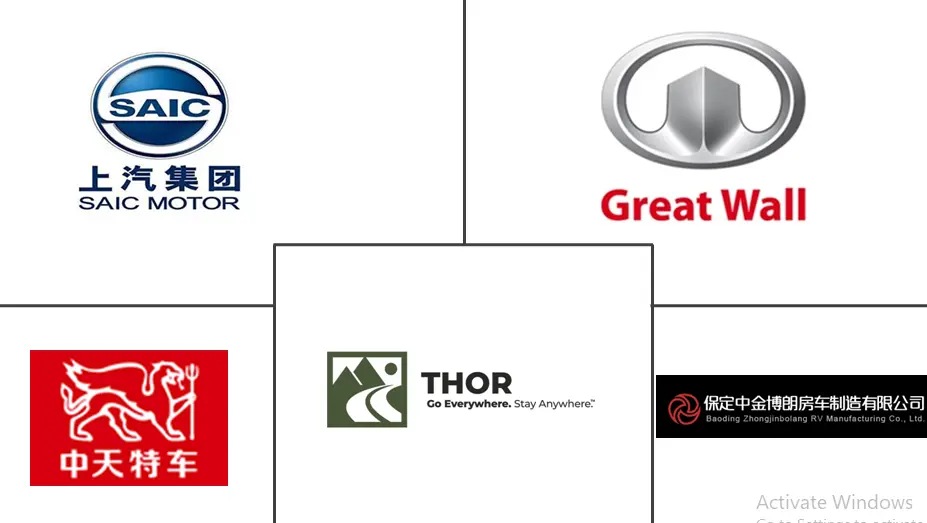Market Size of Asia-Pacific Motor Home Industry

| Study Period | 2019 - 2029 |
| Base Year For Estimation | 2023 |
| Forecast Data Period | 2024 - 2029 |
| Historical Data Period | 2019 - 2022 |
| CAGR | > 9.00 % |
| Market Concentration | Medium |
Major Players
*Disclaimer: Major Players sorted in no particular order |
APAC Motor Home Market Analysis
The Asia-Pacific motorhome market is expected to register a CAGR of over 9%, during the forecast period (2020 - 2025).
- Asia-Pacific is witnessing increasing demand for adventure camping as the number of camping grounds is increasing and along with that supportive plans from governments is expected to support the growth of the motorhome market during the forecast period.
- According to the Chinese government's five-year plan around 4,000 campsites are to be developed by 2020, At the end of 2018 there were around 1300 campsites are there in China. Also, the Chinese car drivers are permitted to enjoy their caravans or motorhomes with a maximum permitted weight of up to 4.5 tonnes.
- Major motorhome manufacturers are adopting various advancements in their class C versions. One of the other trends witnessed in class C models is that the manufacturers are preferring large heavy-duty vehicle chassis for making their motorhome bulky by shifting out from the van chassis. Most of these larger versions are also diesel-powered, making them apt to pull a heavier load while being more fuel-efficient, compared to gasoline engines.
- Although the motorhome culture is in its nascent stage in most of the Asian countries as compared to European and North American countries. But these countries are sleeping giant with tremendous potential for growth in future.
- US Department of Commerce's International Trade Administration estimate that the market volume in the field of motorhomes will increase to up to 300,000 new registrations by 2020.
APAC Motor Home Industry Segmentation
The Asia-Pacific motorhome market covers the latest trends and technological development and provides analysis on market demand from motorhome type, end-user, and country-level analysis as well as the market share of major motor home manufacturing companies across Asia-Pacific.
| By Type | |
| Class A | |
| Class B | |
| Class C |
| By End User | |
| Fleet Owners | |
| Direct Buyers |
| By Country | |
| China | |
| Japan | |
| India | |
| South Korea | |
| Australia | |
| Rest of Asia-Pacific |
Asia-Pacific Motor Home Market Size Summary
The Asia-Pacific motorhome market is experiencing a significant growth trajectory, driven by an increasing interest in adventure camping and supportive government initiatives. The region is witnessing a rise in the number of camping grounds, particularly in China, where the government has plans to develop thousands of campsites. This growth is further supported by regulatory changes allowing larger motorhomes with heavier weights, which are becoming more popular due to advancements in vehicle chassis and engine technology. Despite the motorhome culture being in its early stages compared to Europe and North America, the potential for expansion in Asia-Pacific is substantial. The market is characterized by a mix of local and global players, with companies like Thor Industries and Winnebago Industries expanding their presence through joint ventures and technological innovations.
The motorhome market in Asia-Pacific is fragmented, with numerous local manufacturers and the entry of global giants. The high cost of motorhomes, which are considered luxury items, limits their accessibility, but the availability of used RVs from the US and Europe offers more affordable options. Smaller motorhomes are preferred due to narrow roads and limited parking, enhancing their appeal. Initiatives by organizations like the Japan Recreational Vehicle Association and companies such as Shanghai Auto are promoting RV culture and developing ecosystems to support motorhome tourism. These efforts include partnerships with campgrounds and tourism agencies, as well as the use of mobile apps to facilitate RV rentals and campground bookings. The market's growth is further fueled by strategic acquisitions and collaborations, such as Winnebago's acquisition of Newmar Corporation and Erwin Hymer Group's joint venture with Lingyu Group, which aim to enhance product offerings and market reach.
Asia-Pacific Motor Home Market Size - Table of Contents
-
1. MARKET DYNAMICS
-
1.1 Market Drivers
-
1.2 Market Restraints
-
1.3 Industry Attractiveness - Porter's Five Forces Analysis
-
1.3.1 Threat of New Entrants
-
1.3.2 Bargaining Power of Buyers/Consumers
-
1.3.3 Bargaining Power of Suppliers
-
1.3.4 Threat of Substitute Products
-
1.3.5 Intensity of Competitive Rivalry
-
-
-
2. MARKET SEGMENTATION
-
2.1 By Type
-
2.1.1 Class A
-
2.1.2 Class B
-
2.1.3 Class C
-
-
2.2 By End User
-
2.2.1 Fleet Owners
-
2.2.2 Direct Buyers
-
-
2.3 By Country
-
2.3.1 China
-
2.3.2 Japan
-
2.3.3 India
-
2.3.4 South Korea
-
2.3.5 Australia
-
2.3.6 Rest of Asia-Pacific
-
-
Asia-Pacific Motor Home Market Size FAQs
What is the current Asia-Pacific Motor Home Market size?
The Asia-Pacific Motor Home Market is projected to register a CAGR of greater than 9% during the forecast period (2024-2029)
Who are the key players in Asia-Pacific Motor Home Market?
Thor Industries Inc., SAIC Motor, Great Wall Motor Co., Ltd., Zhongtian Gaoke Special Vehicle Co., Ltd. and Baoding Zhongjin Braun RV Manufacturing Co., Ltd. are the major companies operating in the Asia-Pacific Motor Home Market.

